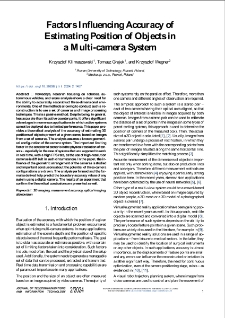Instytut Łączności – Państwowy Instytut Badawczy udostępnia 2 312 obiektów cyfrowych
Obiekt
Tytuł: Factors Influencing Accuracy of Estimating Position of Objects in a Multi-camera System, Journal of Telecommunications and Information Technology, 2024, nr 2
Tytuł publikacji grupowej:
Abstrakt:
Wydawca:
National Institute of Telecommunications
Identyfikator zasobu:
oai:bc.itl.waw.pl:2336 ; ISSN 1509-4553, on-line: ISSN 1899-8852
DOI:
ISSN:
eISSN:
Źródło:
Journal of Telecommunications and Information Technology
Język:
Licencja:
Właściciel praw:
Instytut Łączności - Państwowy Instytut Badawczy
Kolekcje, do których przypisany jest obiekt:
- Biblioteka Cyfrowa Instytutu Łączności > Wydawnictwa Instytutu Łączności > Wydawnictwa bieżące > Journal of Telecommunications and Information Technology (JTIT)
Data ostatniej modyfikacji:
17 lip 2024
Data dodania obiektu:
15 lip 2024
Liczba wyświetleń treści obiektu:
116
Wszystkie dostępne wersje tego obiektu:
https://bc.itl.waw.pl/publication/2648
Wyświetl opis w formacie RDF:
Wyświetl opis w formacie OAI-PMH:
Obiekty Podobne
Padée, Adam Kopka, Przemysław Klimaszewski, Konrad Kuźmicki, Krzysztof Włodarski, Tomasz Kozioł, Sylwester Wiślicki, Wojciech Wójcik, Michał Ćwiek, Arkadiusz Możdżonek, Rafał

